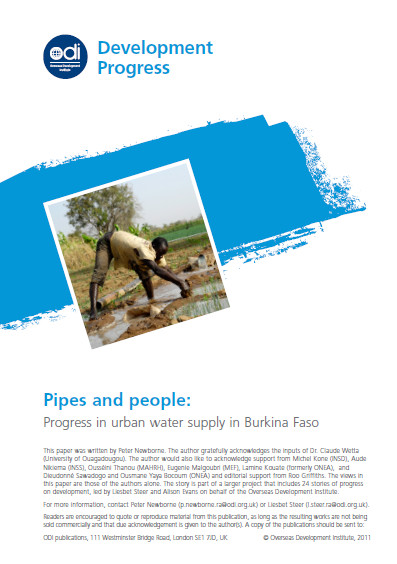Pipes and people: Progress in urban water supply in Burkina Faso
 |
report Jun 2011 ; 16 pages
Aut. Peter Newborne
Ed. ODI - London
Downloadable format: PdF
Downloadable from the publisher
Editor Presentation
Abstract:
In 1998, the government identified this as a policy priority and highlighted the strengthening of the National Office for Water and Sanitation (ONEA) as key. ONEA had been converted in 1994 into a state-owned company, run according to commercial principles, with a Board of Directors and enhanced autonomy to manage its activities across all urban centres of the country. In 2001, ONEA was still a small utility, with some 73,000 active household connections serving fewer than 700,000 people nationwide, just one-third of the urban population - essentially wealthy customers - and 1,600 public standpipes serving another half a million urban residents.
Government policy recognises the social, as well as economic, nature of urban water, confirmed in 2004 in the second generation poverty reduction strategy paper. Subsequently, the National Programme for Water Supply and Sanitation referred to the need to investigate low-cost solutions to provide water services to peri-urban districts, in line with poverty reduction goals. It established a target under the Millennium Development Goals (MDGs) of increasing drinking water access in urban centres in Burkina to 87% by 2015, from a base of 42% (all types of service) in 2000.
Keywords: |
management (CI) (DT) (ET) (ope) , millenium development goals (CI) (DT) (ET) (ope) , urban (CI) (DT) (ET) (ope) , water supply (CI) (DT) (ET) (ope) |
Country: |
Publisher/Broadcaster: |
|
ODI
-
Overseas Development Institute - London - United Kingdom |
If there is a broken link, we will be pleased to receive a message: communication@pseau.org